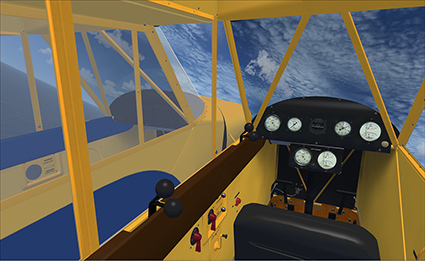Introduction
The Piper Cub, a two seat light aircraft, is one of those
aircraft that has stood the test of time. It is efficient and
simple to fly and makes an ideal trainer.
It's history dates back to pre-war times. In the mid-thirties,
the Cub started out in life as a Taylor E-2, but when the Taylor
Brothers Aircraft Corporation went bankrupt, it was snapped up
by William Piper, a businessman who made his fortune from oil
industry investments. The original Taylor E-2 was made until
1936. The E-2 was reworked and became the J-2 Cub under the
Piper brand and by 1937 the J-2 was improved and updated to the
J-3, the earliest model featured in this package.
When the USA joined WW2 the J-3 was exclusively produced for the
military as the O-59, which became the L-4 model, again,
included in this package. Post war, when Piper reverted pack to
civilian production, the Cub was improved again given a 90hp
engine, much more powerful than the early 56hp engine and the
PA-11 was born.
As we can see from the above, the J-3, L-4 and PA-11 span a date
range of 1937 - 1949, to some, these were the golden years of
aviation. A few of these models are still active today and some
are newly built kit replicas, such is its popularity.
The Cub Package
This really is a Piper Cub lovers paradise, we are offered 17
models and 34 paint schemes. The J-3 and PA-11 are fitted with
wheels, float and ski undercarriage. There are a couple of
specials included like the "Flitfire" its name being derived
from the Spitfire, they were not RAF aircraft but had the
roundels. The PA-11derivative also includes a model called "The
Thing" which was developed by the Wagner Aircraft Company, it is
basically two PA-11's bolted together. It performed well but
never went into production.
The L-4 "Grasshopper" comes in a civilian version with wheels
and military version with wheeled and float variants, here is
the definitive list:
| J-3 Models: Standard version on wheels. Standard version on Edo 1320 Floats. Standard version on skis. Franklin-engined Flitfire. PA-11 Models: Early production version on wheels, skis and Edo 1320 floats. Late production version on wheels, wheel-skis and Edo 2000 floats. The Wagner Twin Cub. |
L-4 Models: AGF (Army Ground Forces) Artillery Spotter. General service model (no radio), otherwise known as a 'Hack'. Post-war, to the present, civilian model (up-rated engine + mixture). Present-day restored military version (up-rated engine + mixture). L-4 Float Models: WWII U.S. Army Liaison. 1949 Civil Air Patrol |
 |
Also included are operation manuals for each version plus a checklist and a paint kit.
Installation
At the time of writing this package only comes on DVD published by Flight1. Included with the DVD is a nice printed pilots manual manual which gives advice on installation, especially concerning Vista and Windows 7 where you really need to switch off User Account Control. Installation is so simple and hands-off, it does it all for you, even searching out your flight sim path, it correctly found my installation on my "X" drive. The only after-action may be to accept the gauges are trusted when you start FSX. The manuals are now available to you via the Windows start menu.
First Impressions
Having so many variants makes it difficult to chose a model unless you have a flight plan and a purpose for your flight. So looking through the models I think we will have to tackle this in chronological order so I should start with the standard J-3 on wheels. Yellow, how's that for a first impression! Initially you are sat in the back for solo flying, everything is painted yellow, the gauges look to be high 3D quality, readable at 1x but I had to zoom in to read them properly.
All you have is a throttle, a stick and rudder pedals on a sort of push me pull you cable attachment that runs around that inside of the cockpit. Superb! Yes it really is that basic, there's no radio or navigation equipment so just get flying. Flaps? no thanks we haven't got any, we can give some nose-up bias via the trim. As we are in the back, the C of G is about perfect. I'm looking forward to trying the float and ski models too.
After lining up and pushing the throttle forward we are airborne some 5 seconds later, some would call this STOL, more like VSTOL!, she is so light the lift is phenomenal especially when the wind is nose-on. In the climb and cruising she is very responsive to all commands.
So with all the other variants to look at let's look in more detail.

|

|
Interior
J-3
Well, you have read above what is inside the J-3, not much really! The gauge detail is very high, the engine rev gauge turns in the opposite direction than you would expect, it's a bit weird but totally right. The cables operating from the rear rudder pedals and the wires out to the ailerons are animated and very smooth.
If you can't find the fuel gauge that's because it is out in front of you on the engine cowling. It's a rod, like a dip stick, that slowly falls as the fuel is used, it is modelled and functional. You could also use the stick as a reference point to the nose when aligning for the runway. .
The right hand door opens with the usual commands however the main door command will open the window which will swing up under the wing, the second door command lowers the bottom panel so that's two commands required to enter and exit the aircraft. I am not sure whether I should fly wilth the window latched open but it gives a lovely clear view that the VC glass doesn't, that is not a complaint, it is as you would expect.
On the internal spars that run from the fuselage to the wings there are click spots to hide / view the pilot, this works for the external view but not on the VC view.
On the left hand side of the cockpit there are dual throttles , one for front and one for rear. Also fuel, trim and water rudder controls for the front seat
Other than the yellow, it would have been nice to see some weathering on the internal panels. As it is very narrow, I would expect to see quite a few scuffs. The floor looked good with a nice wood effect.
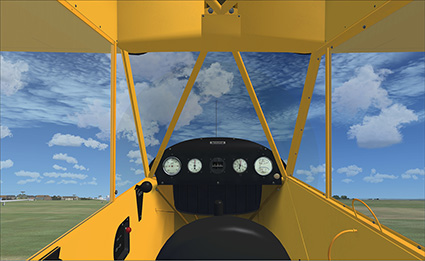
|
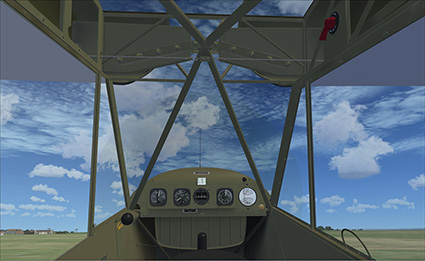
|
L-4
Ah, that's better a nice camo-green! The first thing you notice is it is like sitting in a greenhouse, the roof is mostly glass as is the rear panel so visibility is exceptional. On first view it is very similar to the J-3 sharing the same instruments, albeit they are dark instead of white and fuel gauge.
The all-over green colour in the cockpit also highlights another feature on that the words on the throttle plates etc. are pressed into the metal, that's a nice touch.
The rear seat is not fully fitted like the J-3, this enabled things to be stored behind the seat and the observer to face rearwards, on the AGF variant there is a Jeep-type radio on the rear shelf, it looks pretty heavy!
PA-11
This like being in the lap of luxury! On the later version model, you have up-to-date versions of the old gauges which you will be very familiar with, along with a turn and slip indicator, radio and transponder! The compass has moved from the front panel to on top of the panel.
The fuel gauge is now inside but is still really simple being floating ball in a tube in the left overhead area.
The pilot click spot again only affects the external view, this time we have two click spots, one for the pilot and one for the passenger however, the passenger click spot was not where I expected it to be and after a head-slapping moment I found it on the head of a screw on the panel. Pay more attention to the manual is my advice.
 |
General - Only a 3D VC model is provided, I cannot see a need for a 2D panel as everything is so clear. On all models you can use shift + 1 to enable a pop up that gives you a radio, GPS and transponder, I suppose for modern day use you would have these.
Usually, the J3 and PA-11 would be flown from the back seat and the L-4 from the front as you would normally have an observer or radio equipment in the back. If you don't like this then you can edit the aircraft.cfg file to change the viewpoints. A relatively easy thing to do for most people.
Float and Ski planes
As part of the J3 and L-14 models you get a float variant, this also means you get the water rudder handle in the cockpit too. The J-3 also comes ski equipped and shares the standard cockpit layout.
Exterior
J-3
The overall quality of the exterior model is very good. There are many highlights like the wooden prop with polished chrome spinner and shiny cylinder heads too. The engine cowling is kept sound by the retaining clips on the mounting bolts, cute!
There is some fine detailing on the control cables, the ailerons are operated by cables which run inside the wing and up the wing braces. On the upper wing surface, the cable moves in and out of a raised section and is animated. On the underside, the cable moves but disappears into the wing then out again to a pulley, had we seen the pulley move I would have been extremely impressed. The rudder and rear wheel are spot on, you can see the cables and springs working in unison. The elevators do not appear to have any rods or cables, they just, well, work!
The main suspension is well animated and the tyres are very subtlety textured, typically J-3's and L-4's have smooth tread-less tyres.
 |
All models are fresh out of the factory, I would have really liked to have seen at least one weathered livery, to me that small addition would pay dividends. The camo liveries looked more used and realistic.
I liked the simplicity of the Flitfire paint, even though it is not an RAF aircraft the roundels looked good on it, as did the wheel pants and Franklin labelled cylinder heads.
Both the float and ski versions of the J-3 offer up a basic conversion. There are two ski versions, one of which can only be used on snow, the other can be used on snow and grass as it has built-in wheels into the skis. The float version has what I would describe as a standard float attachment, with a rudder only being fitted to the port float.
 |
L4
These are mostly a camo colour, because of the very nature of camouflage painting the livery looks a whole lot better to me. My favourite is the 2nd Infantry Division with the D Day stripes. The other detailing is very similar to the J-3 except for the greenhouse type canopy and the huge whippy aerial which reacts to high speeds and bends backwards.
 |
Also included are a couple of civilian L-4's, modern day restored versions, the white version is a welcome change from the yellow but stuffers the same spotless finish. More acceptable I suppose as they are just display/demonstration versions rather than work horses.
PA-11
Much more rounded than the J-3 and L-4, you can see the evolution taking place. The nose is much wider and all-encompassing of the cylinders. The ribs on the wings and the fuselage can clearly be seen but the paint is still in factory condition.
 |
This looks almost like a modern day aircraft and wouldn't look too out of place on a modern airfield.
Twin PA-11 - (The thing)
Well this is just downright bizarre! Two PA-11s joined at the hip, The aircraft is extended width wise but not length wise. It has a common wing, with longer struts. Two fuselages and two engines with which the blades appear to overlap each other but they are infact, offset.
 |
The pilot and any baggage only occupies the right hand cockpit only (See above), the left one is not used. In close-up view the details are similar to the PA-11, the two bodies are joined by spars and a common tail plane and wing. The port side has a different livery than the starboard side having a blue tail and broad stripe.
Flying the Cub
Being a trainer and a simple aircraft control-wise, getting her into the air is a breeze. Startup only involves switching the fuel on, priming, throttle open 1/4 inch, mags to both, feet on brakes then start her up. (No that is not my check list!)
Whilst she is warming up you can check both ignition systems and set the altimeter, the usual key command B is used, but then you have to set the zero under the needle, the whole face of the gauge rotates to get the numbers aligned. The altimeter has a range of 0 - 10,000 with 200ft increments so the needle doesn't move a great deal during flight. In fact I often found myself taking visual references for height.
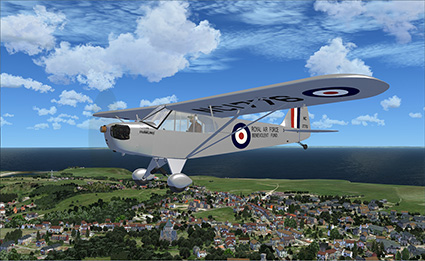
|
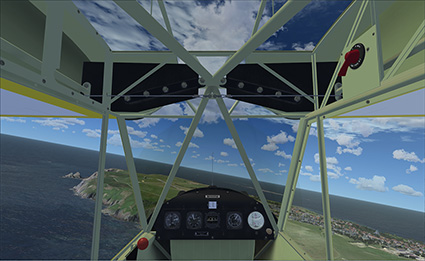
|
The other gauges are beautifully clear and smooth, they are difficult to see in the back seat so I used a secondary window for the oil T&P's.
Setting the trim with my joystick control produces a nice smooth animation in the cockpit. After a while you get to know how much nose up to give her. She will float into the air with no input from me unless a rapid departure is required.

|
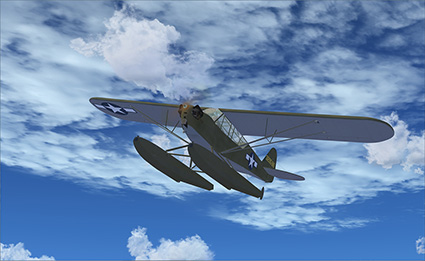
|
So now in the air we're not going anywhere fast, in the climb phase she is wanting to turn left so you still need some right-rudder to keep her straight. My impressions of how real this feels are very, very good. Once we have gained some decent height I went through all the standard maneuvers noting the secondary affects of the ailerons and rudder in banking and turning the aircraft etc. and the results seemed to me to be pretty much on the numbers and the feedback from the aircraft is very believable.
The PA-11 late production model comes with more up to date instruments, the turn-slip indicator will come in handy on judging your co-ordinated turns and those tricky cross-wind landings! The tachometer, airspeed indicator, altimeter and Oil T&P are modern design, also you have a transponder and radio. The reactions from the gauges were again very smooth and obviously very well engineered.
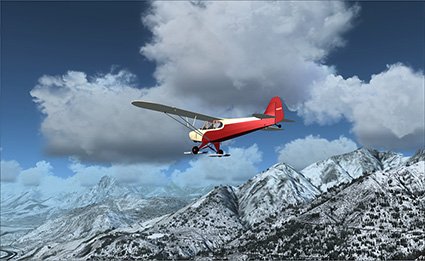
|
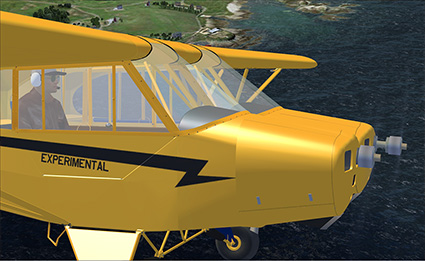
|
After flying around for a while it is time to descend, with the high nose you want to be finding your target at the near end of the runway pretty early on, getting the speed back to around 60 and virtually gliding in. Keeping your target just above the cowling using the power is the key, once you are over the numbers you should be about 50, nose up, loose speed and flare, touching down on all three wheels if you are a show-off!
Now we are taxiing it's back to looking outside using the side window for situational awareness, just park it on the grass, she'll be ok there. Now congratulate yourself on another successful flight and check your log book.

|

|
Flying the float and ski variants are not much different, I didn't notice a great deal of difference in the handling except one, no brakes, so ensure you have chosen a long enough water or snow runway. The Twin-Piper is a lot faster and sportier than the PA-11 but is not that pleasant to fly, not because of this model, it's more to do with the design of the plane and the limited visibility you get on the port side.
Overall the flying experience is pretty faultless and I will definitely keep coming back to these models to fly them again.
Sound
The sound was ok, not it's strongest point and looking further into it I see this:
[FLTSIM]
alias=Piper_J3Cub\sound
That's why then.
Luckily, I had previously invested in the excellent Turbine Sound Studio's Piper Cub Continental A65 sound set, now that will just blow you away and is a worthwhile investment if you intend to use any Piper Cub simulation.
Sim performance
In comparison to other similar default aircraft, this performance is on a par which is a good thing. With my set up on medium-high scenery setting I am getting a steady 60FPS externally and around 50 in the cockpit. With complex, well build scenery, like Earth Simulations Alderney I achieved around 30-40. In all events, no stuttering. I would regard this a top performer sim-speed wise.
![]()
Verdict
This is a great sight-seeing aircraft as well as a basic
trainer.
The amount of variants is staggering for the price,
providing a wide and varied range of experiences. It looses
a point from me for lack-luster sound which for me, helps
in the total immersion of sim flying.
But overall, this is a high quality and high performing
product which gets my backing!
Mutley's Hangar score of 9/10
![]()
Joe Lawford
Review machine Spec: Core i7 Extreme 965 @ 3.6 Ghz
| 12Gb Corsair DDR3 Ram |GTX580 Graphics |Windows 7 64bit
Addons Used: REX2, Earth Simulations Alderney,
Approaching innsbruck, ENB Series HD mod(Some shots), No edits.

